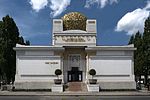First Austrian Republic

The First Austrian Republic (German: Erste Österreichische Republik), officially the Republic of Austria, was created after the signing of the Treaty of Saint-Germain-en-Laye on 10 September 1919—the settlement after the end of World War I which ended the Habsburg rump state of Republic of German-Austria—and ended with the establishment of the Austrofascist Federal State of Austria based upon a dictatorship of Engelbert Dollfuss and the Fatherland's Front in 1934. The Republic's constitution was enacted on 1 October 1920 and amended on 7 December 1929. The republican period was increasingly marked by violent strife between those with left-wing and right-wing views, leading to the July Revolt of 1927 and the Austrian Civil War of 1934.
Excerpt from the Wikipedia article First Austrian Republic (License: CC BY-SA 3.0, Authors, Images).First Austrian Republic
Rechte Wienzeile, Vienna Innere Stadt
Geographical coordinates (GPS) Address Nearby Places Show on map
Geographical coordinates (GPS)
| Latitude | Longitude |
|---|---|
| N 48.2 ° | E 16.366666666667 ° |
Address
Rechte Wienzeile
Rechte Wienzeile
1010 Vienna, Innere Stadt
Austria
Open on Google Maps








